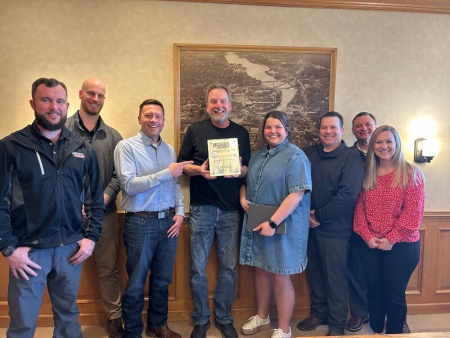By Ken Thompson
CYLINDERS – they are heavy, hard to safely manipulate, often need a fresh coat of paint, and do little more than ‘house’ gaseous goods that are so extremely important to mankind, that we cannot do without them. The distribution of gases absolutely demands their presence. Some of us choose to be in that business!
First of all, cylinders cost a lot of money, and more frequently than not, are ‘worth’ far more than the gases they contain. It’s not unusual that a $300 cylinder is required to deliver $2.00 worth of oxygen. Consider for a moment that a distributor delivering one cylinder of oxygen to the muffler shop will likely have a second cylinder on his truck for replacement of the one in use at the muffler shop, and a third on his fill rack back at the plant being filled. Looks like that is close to a $1,000 investment to satisfy a very small sale.
And that is only scratching the surface. Cylinders represent a potential danger – they are heavily regulated – and should be. Housing a flammable, corrosive, oxygen-depleting, or poisonous gas in a cylinder charged at pressures to 3,000 psi demands lots of respect and care. First, the cylinder integrity itself must be guaranteed, and that takes periodic testing, recording, and reporting required by law. Those processes all carry a cost. Cylinder valves must be maintained to precise working order. Safety devices must be installed, checked, maintained, and recorded each time the cylinder is processed. More time, motion, and MONEY. OSHA requires proper segregation in storage, securing, and handling. More costs for training and compliance; nasty fines if ignored. Total risk analysis is evaluated by insurers and property and casualty insurance premiums are generally quite substantial, even without a history of an incident.
Of course, they must be transported – on heavy, very costly vehicles, themselves expensively regulated, and operated by experienced, government-certified drivers – costly to hire, train, support, and retain. The deliveries themselves often take place in hot, humid temperatures, snow, rain, and sleet. Every day’s ideal conditions!
Yes, use fees are charged – and must be – for the time the cylinder is in a user’s possession. These fees have necessarily risen over years as all costs surrounding them have increased. Those using cylinders must also be responsible for the protection of the supplier’s asset; and be accountable for the replacement cost for loss or damage to the cylinder. Managing cylinder activity is almost a business ‘within a business’.
Technology has come to our rescue.
First in the form of cylinder tracking. Barcoding enables us to collect important cylinder information – serial numbers, manufacturing history, and testing records. In some cases, we have advanced to the use of embedded neck ring chips and/or QR codes. With a cylinder individually identified, tracking software can account for the physical location of the cylinder and follow the transactions leading to its time in the hands of the user. That establishes customer accountability for the actual asset, and can accurately determine use fees. Even in the case of a large and chaotic construction site, where multiple contractor customers might easily intermix cylinders, the tracking system will follow the cylinder so that the proper user is correctly invoiced and the actual asset is not LOST among contractors. By itself, the tracking software is responsible for resolving disputes that all too frequently disrupted relations between distributors and cylinder users.
Actual fill plant systems are enormous beneficiaries of software design and upgrades. Touch screen PLCs assist in the safe filling of cylinders by measuring weights, capacities, pressurization formula, ambient temperature considerations,
and fill time cycles. Systems contain a full menu of safety considerations with fail-safe interrupters to guard against operator error. Safety, efficiency, productivity, and operator comfort have all been addressed. Cylinder handling has been simplified through palletization, moving fill heads, and safe and efficient valve quick connect hardware. Palletizing moves beyond the plant, onto specially designed truck beds where they are secured into place during transport and can be delivered in pallet load quantities, or cylinders can be handled individually through center aisles on the truck bed.
Logistics surrounding the actual movement of cylinders has improved as a result of a whole suite of software innovations. Customer use patterns can be determined in advance and truck loading planned for each day’s delivery schedule. The day’s actual route, stop sequences, estimated delivery times, and on-site duration, are all embedded in Routing Software packages. Coordinated GPS systems permit ‘real time’ adjustments that would surface as the result of unplanned disruptive events such as closed roads or mechanical malfunctions. The same software insures that truck loading complies with regulated weight limits, and reports operators’ compliance with traffic laws.
High-pressure cylinders will always be the primary package for the delivery of pressurized gas products. There are tens of millions of them in service throughout the world. However, larger consumers of both gaseous and cryogenic product will be served with a variety of gas packaging alternatives. Cylinders can be manifolded together or ‘bundled’ to reduce the handling of individual cylinders and time-consuming, production interrupting, connecting and disconnecting. A single portable liquid container, with a variety of vaporization and pressure-building devices can provide volumes equal to eight to ten high-pressure cylinders. They, too, can be bundled together to minimize handling, downtimes, and less frequent connection procedures. Available micro-bulk, mini-bulk, all the way up to large capacity cryogenic vessels offer endless supply alternatives, all sized to a user’s specific needs. Technology now provides many ways to monitor the consumption of these gas products, whether it is through pressure drop, flow rates, liquid levels, or temperature variables. This telemetry can be deployed to measure single cylinder usage, or over many and varied containers positioned in tank farms.
These telemetry systems are not only a critical element in guaranteeing certain operating parameters are maintained, but they also serve as the basis for logistics management by predicting economic re-supply cycles. It effectively provides a vendor-managed inventory system for the benefit of the user, while allowing the supplier to minimize costs through efficient delivery cycle management. The new world of B2B relationships allows all this data to be integrated into the automated exchanges taking place between supplier and customer ERP platforms. And just around the corner and fast approaching is AI, which will give us even more.
It is the CYLINDER, in its many different configurations, that has served as a barrier of entry to many other distribution business models. Anyone with enough resources can buy a bunch of cylinders. It is a deep dive into the understanding of the management of these assets in the overall conduct of a safe and successful distribution business model that makes many otherwise curious people take pause. If gases could be shipped in cardboard cartons, they would be on every UPS, FedEx, or Prime truck!
And finally, cylinder ownership and its contribution to the financial health of a distributorship cannot be overlooked. Owning an asset with a useful life of approximately 30 to 40 years, that has long since been fully depreciated, and in the service of clients paying monthly rental fees have generated both margin and cash flows that create positive impacts on a company’s EBITDA. When an owner decides it is time to pass the business on to a new owner, multiples paid for by a company with solid cylinder assets and documented rental receipts are likely to be very generous.
YES, we love our CYLINDERS!








